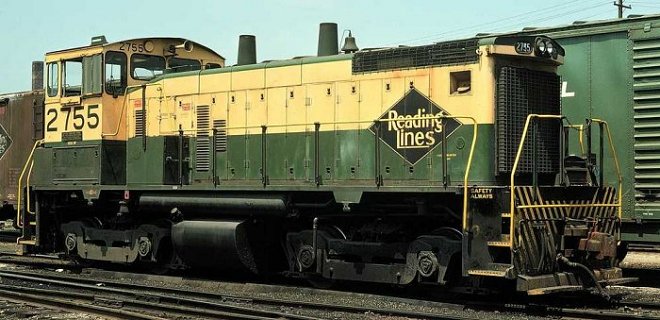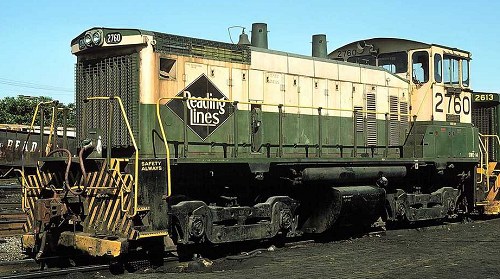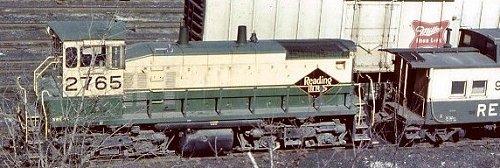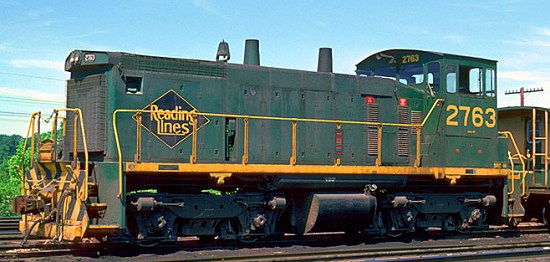EMD: SW-1500

In addition to its practice of rebuilding and modernizing older switching units, the Reading also purchased several new switchers during its move to second-generation power during the 1960s. The Reading took delivery of eleven EMD SW-1500 switching locomotives in the summer of 1966. The SW-1500s included EMD's 1500 horsepower 645E prime mover, an improvement over the earlier common 567 engine. The first flight of SW-1500s was numbered 2750-2760 and were assigned the class SWE-14.

The Reading's first 11 SW-1500s were delivered with an 1100 gallon fuel tank and AAR-B switcher trucks like older switching locomotives. In addition, these units included a watchman heater which took the appearance of a large box installed along the engineer's side of the locomotive, and can be seen in the photo of #2755 above.
Three years later the Reading purchased an additional 10 units, which were numbered 2761-2770. This second group of SW-1500s did not have the watchman heater box, and were delivered with new Flexicoil trucks, as can be seen in the below photo of #2765. Some reports indicate that the older AAR-B truck design caused problems for the locomotives when negotiating the industrial trackage of the Philadelphia area. The Flexicoil truck handled the tight curves better, and also allowed a top speed of 60mph, which permitted the SW-1500s to be used in local freight service rather than solely as a yard engine.
Initially, the Reading's SW-1500s could be seen most often at Abrams Yard outside of Norristown, PA, as well as at Rutherford Yard near Harrisburg. During the 1970s they were also used in local service on Philadelphia suburban branchlines. In addition, they could occasionaly been seen in road service, mixed in with road units until 1971 when the practice was discontinued. In later years they were also seen further up the Schuylkill Valley in locales such as Pottstown, Birdsboro and Reading, Rupert and West Milton.
 One Reading SW-1500, #2763, was painted in the 1970s "Reading Green" scheme after being rebuilt in 1974 after being smashed by a runaway grain hopper at Port Richmond. This repainting led #2763 to resemble the Reading's MP-15 locomotives #2771-2780, although the MP-15s rode on Blomberg trucks and had several other distinctive spotting features. All 21 units lasted into the Conrail era.
One Reading SW-1500, #2763, was painted in the 1970s "Reading Green" scheme after being rebuilt in 1974 after being smashed by a runaway grain hopper at Port Richmond. This repainting led #2763 to resemble the Reading's MP-15 locomotives #2771-2780, although the MP-15s rode on Blomberg trucks and had several other distinctive spotting features. All 21 units lasted into the Conrail era.
MODELING NOTES: The SW-1500s would be appropriate along the Main Line, Philadelphia-area branch lines, Rutherford and the Lebanon Valley branch. They also occasionally were seen in the coal regions, including Rupert and West Milton. When modeling one of these units, remember that there was a three-year difference between the arrival of the first 11 units and the last 10.
If modeling units in the #2750-2760 "class," remember to model the AAR-B truck sideframes. These are available as a separate detail part from several manufacturers - the Reading sideframes were roller bearing, so it wouldn't really be appropriate to simply swap in a pair of friction-bearing switcher sideframes. Finally, the watchman heater box along the engineer's side of the locomotive can be fabricated from strip and sheet styrene. After installing, you will need to build a new handrail using appropriately sized wire. Our recommendation would be to use the stock handrail up to the point of the stanchion closest to the angle. Cut the wire so that it terminates halfway inside the stanchion. Then, fabricate the remainder of the handrail from the cab to that stanchion, and terminate it inside the stanchion, so that the joint between the two pieces of wire is hidden. If you're adding grab irons, note that there was a grab iron mounted on the watchman heater box on the side facing the front of the unit, as can be seen in the top photo.
Did You Know?
Downloads
 A variety of Reading Company operations related documents, etc. that may be of use in your modeling efforts.
A variety of Reading Company operations related documents, etc. that may be of use in your modeling efforts.
 A variety of Reading Company operations paperwork, such as train orders, clearance forms, etc. that will help you operate your Reading layout in a prototypical manner.
A variety of Reading Company operations paperwork, such as train orders, clearance forms, etc. that will help you operate your Reading layout in a prototypical manner.
 Public Timetables, Employe Timetables, and Rulebooks that provide much useful operational information.
Public Timetables, Employe Timetables, and Rulebooks that provide much useful operational information.
 Signs, billboards, and other FREE goodies for your use. We ask only that you help spread the word about The Reading Modeler!
Signs, billboards, and other FREE goodies for your use. We ask only that you help spread the word about The Reading Modeler!

